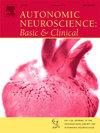Sacral nerve electrical stimulation (SNES) ameliorates bladder dysfunction and detrusor fibrosis in early-stage spinal cord injury: A randomized controlled experimental study in rats
IF 3.3
4区 医学
Q2 NEUROSCIENCES
引用次数: 0
Abstract
This study evaluated the therapeutic effects of sacral nerve electrical stimulation (SNES) targeting the L6-S1 spinal nerves on neurogenic bladder dysfunction following spinal cord injury (SCI). Using a randomized controlled design, 80 female Sprague-Dawley rats were divided into four groups: sham surgery, complete T9 spinal cord transection (SCI model), SCI with electrode implantation only (control), and SCI with active SNES (3–5 Hz, 3–5 V daily for 4 weeks). Bladder function was assessed through urodynamics, while detrusor fibrosis was examined using histological and ultrastructural analyses.
The SCI model group demonstrated significant urodynamic impairments compared to sham controls, including increased leak point pressure (43.15 ± 1.37 vs 25.52 ± 1.29 cmH2O) and decreased bladder capacity (1.52 ± 0.21 vs 4.21 ± 0.72 mL) and compliance (0.21 ± 0.14 vs 0.42 ± 0.26 mL/cmH2O; all P < 0.01). SNES treatment substantially reversed these abnormalities (P < 0.01 vs SCI group), restoring parameters to near-normal levels. Histological examination revealed that SNES significantly reduced collagen deposition (types I and III) in detrusor muscle compared to untreated SCI animals (P < 0.05). Transmission electron microscopy showed preserved mitochondrial structure in SNES-treated animals, contrasting with the cellular vacuolization observed in SCI controls.
These results demonstrate that early intervention with SNES at the L6-S1 level can effectively mitigate both functional and structural bladder impairments following SCI. The treatment improved urodynamic parameters while reducing fibrotic changes in detrusor muscle, suggesting its potential as a species-specific neuromodulation strategy for neurogenic bladder. This study provides experimental evidence supporting further investigation of sacral-level neuromodulation for SCI-related bladder dysfunction.
骶神经电刺激(SNES)改善早期脊髓损伤大鼠膀胱功能障碍和逼尿肌纤维化:一项随机对照实验研究
本研究评价了骶神经电刺激(SNES)对L6-S1脊神经损伤后神经源性膀胱功能障碍的治疗效果。采用随机对照设计,将80只雌性Sprague-Dawley大鼠分为4组:假手术组、完全T9脊髓横断组(SCI模型)、单纯电极植入组(对照组)和活动SNES组(3-5 Hz,每天3-5 V,持续4周)。通过尿动力学评估膀胱功能,通过组织学和超微结构分析检查逼尿肌纤维化。与假手术对照组相比,脊髓损伤模型组表现出明显的尿动力学损伤,包括泄漏点压力增加(43.15±1.37 vs 25.52±1.29 cmH2O),膀胱容量减少(1.52±0.21 vs 4.21±0.72 mL)和依从性(0.21±0.14 vs 0.42±0.26 mL/cmH2O);所有P <;0.01)。SNES治疗显著逆转了这些异常(P <;0.01 (SCI组),参数恢复到接近正常水平。组织学检查显示,与未治疗的SCI动物相比,SNES显著减少了逼尿肌胶原沉积(I型和III型)(P <;0.05)。透射电镜显示,与脊髓损伤对照组相比,snes治疗动物的线粒体结构保存完好。这些结果表明,早期干预L6-S1水平的SNES可以有效减轻脊髓损伤后的功能性和结构性膀胱损伤。该疗法改善了尿动力学参数,同时减少了逼尿肌的纤维化变化,这表明它有可能作为一种神经源性膀胱的物种特异性神经调节策略。本研究为进一步研究骶椎水平的神经调节对sci相关膀胱功能障碍的影响提供了实验证据。
本文章由计算机程序翻译,如有差异,请以英文原文为准。
求助全文
约1分钟内获得全文
求助全文
来源期刊
CiteScore
5.80
自引率
7.40%
发文量
83
审稿时长
66 days
期刊介绍:
This is an international journal with broad coverage of all aspects of the autonomic nervous system in man and animals. The main areas of interest include the innervation of blood vessels and viscera, autonomic ganglia, efferent and afferent autonomic pathways, and autonomic nuclei and pathways in the central nervous system.
The Editors will consider papers that deal with any aspect of the autonomic nervous system, including structure, physiology, pharmacology, biochemistry, development, evolution, ageing, behavioural aspects, integrative role and influence on emotional and physical states of the body. Interdisciplinary studies will be encouraged. Studies dealing with human pathology will be also welcome.

 求助内容:
求助内容: 应助结果提醒方式:
应助结果提醒方式:


